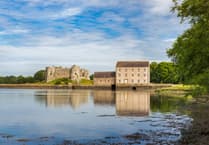Further to the article on page 35 of the Tenby Observer (September 6), I write, once again, regarding the South Beach, Tenby. In a previous letter to the Observer, I likened South Beach to the ‘Coal tips that were my childhood playgrounds in the 1950s, with the exception that South Beach is washed twice a day’. In those days, we came to Tenby for its ‘Golden Sands’.
To quote Tenby town Mayor, Clr. Tony Brown, “it was time the authority did something.” Presumably he means Pembrokeshire County Council, PCC. In an attempt to encourage PCC to take positive action, I am copying this letter to PCC CEO Ian Westley.
When I first met Mr. Westley just over three years ago, some of his staff had made a mailing error involving two opposing parties. I was pleasantly amazed at his immediate action to rectify matters and to see that his staff had been impartial in the error. I was even more impressed when he said, and I quote, “The buck stops with me”.
Mr. Westley, I hope you still have the same attitude to your job. Tenby’s South Beach needs positive action from PCC to tackle the disappearing sand. To my knowledge this ‘Buck’ has been passed from pillar to post, ever since the storms of 2013/14, when I walked South Beach to Giltar on an almost daily basis.
I have several friends who are lifelong residents of Tenby, and whose memories reach back for about the last 80 years. Without fail they are of the opinion that the groynes, which used to be at the Giltar end of the beach, helped negate this ‘entirely natural response’. Yes, there will always be natural movement of sand, but to imply that we must not interfere with natural processes is disingenuous. Humans have always interfered with natural processes to suit their own needs.
In the debate regarding groynes, I would suggest that it was ‘penny wise and pound foolish’ for PCC to remove the existing groynes on, I think, Health and Safety grounds without replacing them.
The following link might be worth considering by those in authority!
https://theconstructor.org/water-resources/hydraulic-structures/groynes-classification/30554/A groyne is a rigid hydraulic structure built either from the shore (in case of seas) or bank (in case of rivers) in order to dissipate the wave energy or to protect the banks from erosion by trapping the sediments.
In the past, I have copied my several letters on the problem of South Beach to both our MP Simon Hart and AM Angela Burns. Simon’s reply stated that he was ‘keeping an eye on the Observer story’. Angela’s response, after communication from Dr. S. P. Jones, Director of Community Services, appears to be that the current removal of sand is just ‘short term’. It will be interesting to see the result of the coming winter’s storm. I hope that I am wrong in expecting even more devastation!
Dr Jones, correctly, states that “The movement of sand on South Beach is considered to be an entirely natural response to the storms that we experience”. He also refers to “the infilling of the Ritec estuary after the railway was constructed in the 1850s”, about 170 years ago.
As a start to solving the problem, it is surely worth PCC considering replacing the Giltar groynes, be they wood, concrete rip-rap. Perhaps some bright young engineer might even be able to design groynes that generate intermittent power!
C. J. Roberts,
Pembroke.




